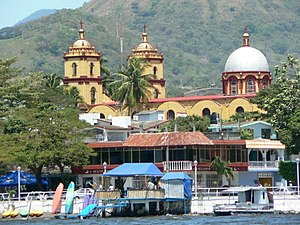
Veracruz, formally Veracruz de Ignacio de la Llave, officially the Estado Libre y Soberano de Veracruz de Ignacio de la Llave, is one of the 31 states which, along with Mexico City, comprise the 32 Federal Entities of Mexico. Located in eastern Mexico, Veracruz is bordered by seven states, which are Tamaulipas, San Luis Potosí, Hidalgo, Puebla, Oaxaca, Chiapas, and Tabasco. Veracruz is divided into 212 municipalities, and its capital city is Xalapa-Enríquez.
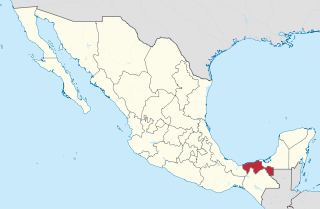
Tabasco, officially the Free and Sovereign State of Tabasco, is one of the 32 Federal Entities of Mexico. It is divided into 17 municipalities and its capital city is Villahermosa.

Tuxtla Gutiérrez, or Tuxtla,(Spanish:[ˈtuɣstlaɣuˈtjeres], Nahuatl:[ˈtuʃt͡ɬa]) is the capital and the largest city of the Mexican southeastern state of Chiapas. It is the seat of the municipality of the same name, the most developed and populated in the state. A busy government, commercial and services-oriented city, Tuxtla had one of the fastest-growing rates in Mexico in the last 40 years. Unlike many other areas in Chiapas, it is not a major tourist attraction, but a transportation hub for tourists coming into the state, with a large airport and a bus terminal.

Catemaco is a city in Catemaco Municipality located in the south of the Mexican state of Veracruz. The city is located on Lake Catemaco, with the municipality stretching north to the Gulf of Mexico. Catemaco is a tourist destination, with its main attractions being the lake, remnants of the region's rainforest and a tradition of sorcery/witchcraft that has its roots in the pre-colonial period and is mostly practiced by men. This tradition is well-known in Mexico and attracts clients from various walks of life, including businessmen and national-level politicians. Catemaco holds an annual event in March dedicated to sorcery, which can draw up to 5,000 visitors.

Laguna Catemaco is a freshwater lake located at the center of the Sierra de Los Tuxtlas in south central Veracruz near the city of Catemaco, in east central Mexico.

Los Tuxtlas is a region in the south of the Mexican state of Veracruz.

Sumidero Canyon is a deep natural canyon located just north of the city of Chiapa de Corzo in the state of Chiapas, in southern Mexico. The canyon's creation began around the same time as the Grand Canyon in the U.S. state of Arizona, by a crack in the area's crust and subsequent erosion by the Grijalva River, which still runs through it. Sumidero Canyon has vertical walls which reach as high as 1,000 metres (3,300 ft), with the river turning up to 90 degrees during the 13-kilometre (8 mi) length of the narrow passage.
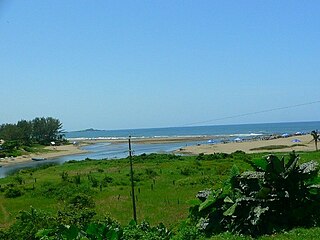
Montepío is a small village on the Gulf Coast of Mexico, within the San Andrés Tuxtla municipality, Veracruz, 1 hour away from the major tourist center of Catemaco.

Santiago Tuxtla is a small city and municipality in the Mexican state of Veracruz. The area was originally part of lands granted to Hernán Cortés by the Spanish Crown in 1531. The city was founded in 1525, but it did not gain municipal status until 1932. Today, the municipality is poor and agricultural, but is home to several unique traditions such as the Santiago Tuxtla Fair and the Acarreo de Niño Dios, when images of the Child Jesus are carried in procession several times during the Christmas season. It is also home to the Museo Regional Tuxteco which houses much of the area's Olmec artifacts, including a number of colossal heads and other monumental stone works. The city's main plaza hosts the largest Olmec colossal head in Mexico, thus making it famous.
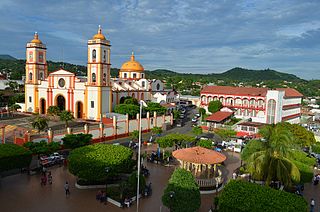
San Andrés Tuxtla is a city and municipality in the south of the Mexican state of Veracruz. The city is the largest in the Los Tuxtlas region. It was founded after an eruption of the San Martín Volcano pushed people into this valley during the early colonial period. Since the 19th century, the area has been the center of Mexico's production of fine tobacco, mostly used in the making of cigars.
Lerdo de Tejada is a municipality in the Mexican state of Veracruz, located 207 kilometres (129 mi) southeast of the state capital Xalapa. It is named after Sebastián Lerdo de Tejada, the 27th President of Mexico.
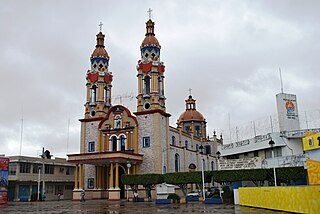
Paraíso is a town and municipality located in the north of the Mexican state of Tabasco, about 75 km due north of the state capital of Villahermosa on the Gulf of Mexico. Much of the area is traditionally dedicated to fishing and agriculture. Today, it is also an oil-producing area with the mostly oil-dedicated port of Dos Bocas. There is also some tourism connected to the area's beaches and natural attractions, and the area is promoted under the state's Cacao Route tourism program.
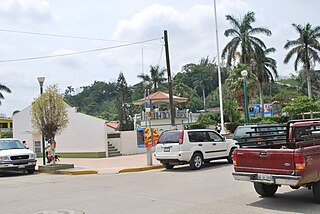
Cazones de Herrera, or Cazones, is a town and municipality located in the north of the Mexican state of Veracruz on the Gulf of Mexico. While it has tourist attractions along its shore, especially in the Barra de Cazones area, the municipality, including the seat, has a high level of socioeconomic marginalization. Most of the municipality's population works in agriculture.
Tatahuicapan de Juárez or Tatahuicapan is a municipality located in the south-east of the Mexican state of Veracruz. It was created in 1997 with an area of 208.06 km2.

Hermosillo is a municipality in Sonora in north-western Mexico. The municipal seat is the city of Hermosillo.
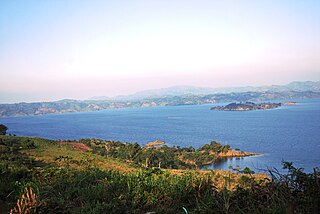
The Malpaso Dam, officially known as the Nezahualcóyotl Dam, is located in the Centro region of Chiapas, Mexico near the border with Tabasco and Veracruz. It was the first of several major dams built on the Grijalva River to generate hydroelectric energy and has the second largest reservoir in Mexico, after the Belisario Dominguez Dam. Construction of the dam occurred in the 1960s and flooded not only the riverbed but also hectares of rainforest and farmland, various towns and villages and archeological sites. These include the former town of Quechula, whose 16th century Dominican church will appear when water is at low levels, and the archeological site of San Isidro which contains one of only two known double Mesoamerican ball courts. Commissioning of the dam's 1,080 MW power station began in 1969 and ended in 1977. The reservoir and later construction of a federal highway has spurred ecotourism in the area.
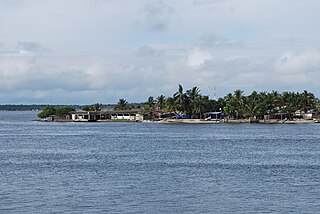
Sánchez Magallanes is a small fishing town and port located in the far northwest of the state of Tabasco, Mexico in the municipality of Cárdenas. It is named after a leader in the French Intervention in Mexico, Coronel Andrés Sánchez Magallanes. The town is located on small peninsula which is between the Gulf of Mexico and a lagoon called Del Carmen, which the port faces. Fishing is the main economic activity here, especially the production of oysters, although there is tourism and oil production as well. The last has been problematic for fishing and tourism due to pollution. The most serious environmental problem is the erosion of the area’s fragile beaches, especially the thin strips of land between the Gulf and the lagoons.

Eyipantla Falls is a waterfall located in the Los Tuxtlas region of southern Veracruz in Mexico. It is forty meters wide and fifty meters tall and is the largest and most important waterfall in the region.
